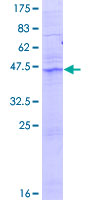order histories, retained contact details for faster checkout, review submissions, and special promotions.
Forgot password?
order histories, retained contact details for faster checkout, review submissions, and special promotions.
Location
Corporate Headquarters
Vector Laboratories, Inc.
6737 Mowry Ave
Newark, CA 94560
United States
Telephone Numbers
Customer Service: (800) 227-6666 / (650) 697-3600
Contact Us
Additional Contact Details
order histories, retained contact details for faster checkout, review submissions, and special promotions.
Forgot password?
order histories, retained contact details for faster checkout, review submissions, and special promotions.
ACER2
alkaline ceramidase 2
Hydrolyzes the sphingolipid ceramide into sphingosine and free fatty acid. Unsaturated long-chain ceramides are the best substrates, saturated long-chain ceramides and unsaturated very long-chain ceramides are good substrates, whereas saturated very long-chain ceramides and short-chain ceramides were poor substrates. The substrate preference is D-erythro-C(18:1)-, C(20:1)-, C(20:4)-ceramide > D-erythro-C(16:0)-, C(18:0), C(20:0)-ceramide > D-erythro-C(24:1)-ceramide > D-erythro-C(12:0)-ceramide, D-erythro-C(14:0)-ceramides > D-erythro-C(24:0)-ceramide > D-erythro-C(6:0)-ceramide. Inhibits the maturation of protein glycosylation in the Golgi complex, including that of integrin beta-1 (ITGB1) and of LAMP1, by increasing the levels of sphingosine. Inhibits cell adhesion by reducing the level of ITGB1 in the cell surface. May have a role in cell proliferation and apoptosis that seems to depend on the balance between sphingosine and sphingosine-1-phosphate.
| Gene Name: | alkaline ceramidase 2 |
| Synonyms: | ACER2, Alkaline ceramidase 2, ASAH3L, Ceramide hydrolase, HaCER2, Alkaline CDase 2, AlkCDase 2, ALKCDase2 |
| Target Sequences: | NP_001010887.2 Q5QJU3 |
Publications (1)

If you do not find the reagent or information you require, please contact Customer.Support@LSBio.com to inquire about additional products in development.









